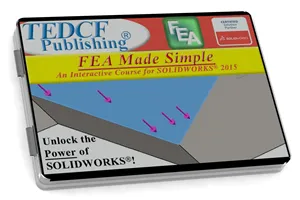Make bulletproof models and know what makes them structurally sound!
Learn how to test the stress of your parts, and discover best practices for using FEA in SolidWorks Premium. There are many advanced concepts taught in the SolidWorks 2014: FEA Made Simple course. So it's important to have a strong foundation of skills in SolidWorks 2015 when you begin. The course has over 4.3 hours of instruction that shows you practical ways of working with SolidWorks FEA. So you'll be able to use it as a tool instead of a mysterious question mark.
The course starts by showing you how to setup a basic static simulation. You'll setup the settings that control the simulation, see the effect of changing settings, and practice changing the output settings. The goal here is to give you a complete understanding of the FEA user interface and the settings that drive it.
As you continue through the course you'll learn how to apply sensors to your model and examine the physical characteristics of you model at a specific location. You'll learn about shear and normal stresses and how to use Mohr's circle to analyze these stresses. This clears the path for an easy to understand description of principal stresses. All the stresses displayed by your sensor will be clearly described and easy to understand.
Once you have all the basic stresses and strain under your belt it will be easy to understand Von Mises Stress. Von Mises Stress is the default stress in stress reports, but you need to understand it to know if it's the stress you should use. Von Mises Stress can also be misleading. So if you do use Von Mises Stress you need to truly understand it. This course explains Von Mises Stress in detail, and makes it easy to understand.
It also shows you how to do simple hand calculations to confirm the accuracy of studies. It doesn't use heavy mathematics. It shows simple tips and tricks to confirm the results make sense. You will learn how to let the computer do all the heavy lifting. All you need to do is confirm the results are close to your estimations. You'll know how it's done and it will be easy to apply.
The course explains the details about mesh elements, how they work, and the difference between mesh types. It also explains which mesh type corresponds to a specific study type. You'll also learn how to analyze trusses and calculate their stresses. This course is packed with tips and tricks to simplify FEA and leverage its power.
You'll also gain an intuitive approach to setting up your studies. For example you'll learn that it makes sense for stresses to rise in sharp corners. You'll know how to increase mesh density in these areas and you'll know why you need to do this.
By the time you finish this course you will be confident about your ability to use FEA.
49 Lessons (Listed Below)
4.3 hours of instruction
Browse through the lessons from the following SolidWorks 2015 courses and watch sample lessons.
SolidWorks 2015: Professional Modeling SolidWorks 2015: Advanced Parts & Assemblies SolidWorks 2015: Mechanical Drawings SolidWorks 2015: Sheet Metal Design SolidWorks 2015: FEA Made SimpleOur SolidWorks courses require No Installation. You can watch them on any device connected to the internet.
You will receive an email containing your User Name and Password. Login to your account and start learning. It's that easy.
While you're logged into your account you can download files used in the courses, watch lessons, and practice the tasks taught in the lessons. Keep in mind that you will use your installation of SolidWorks® to practice.
Get your SolidWorks® 2015 training now. You can start learning in minutes.
SolidWorks® 2015:
FEA Made Simple
No Installation Required
Watch from any device connected to the internet.

$59.95 - $229.95
Watch Sample Lessons
Watch the first hour of the Professional Modeling course for SolidWorks 2015.
 Click to Watch!
Click to Watch!FEA Made Simple
4.3 hours of instruction
Lessons
Introduction
Simulation Setup
Basic Static Simulation
Basic Static Study Results
Normal Stress
Sensors
Shear and Normal Stresses
Principal Stress Intro
Mohr's Circle
Coordinate Systems
Principal Stresses
Von Mises Stress
Normal vs Von Mises
Calculating Bending Stress
Equivalent Moments and Forces
Couples and Moments
Common Sense Deduction
Torsion and Shear
Combined Loads and Stresses
Point vs Area Loads
Hand vs FEA Calculations
Separate Bending and Torsion
Iso Clipping
Mesh Elements
Second Order Elements
Mesh Controls
Automatic Mesh Transitions
Curvature Based Meshes
Beams
Beam Slenderness Ratio
Understand Direction 1 2
Beam Analysis
Profile Stresses
Tapered Beams
Tapered Beam Elements
Introduction to Trusses
Method of Joints
Force Propagation
Constraining Trusses
Truss Study Details
Fixing Truss Joints
Solving Short Beam Problems
Fixing Unstable Models
Shell Elements
Convert Solid to Shell
Shell Study Details
Design by Displacement
Factor of Safety
Conclusion
